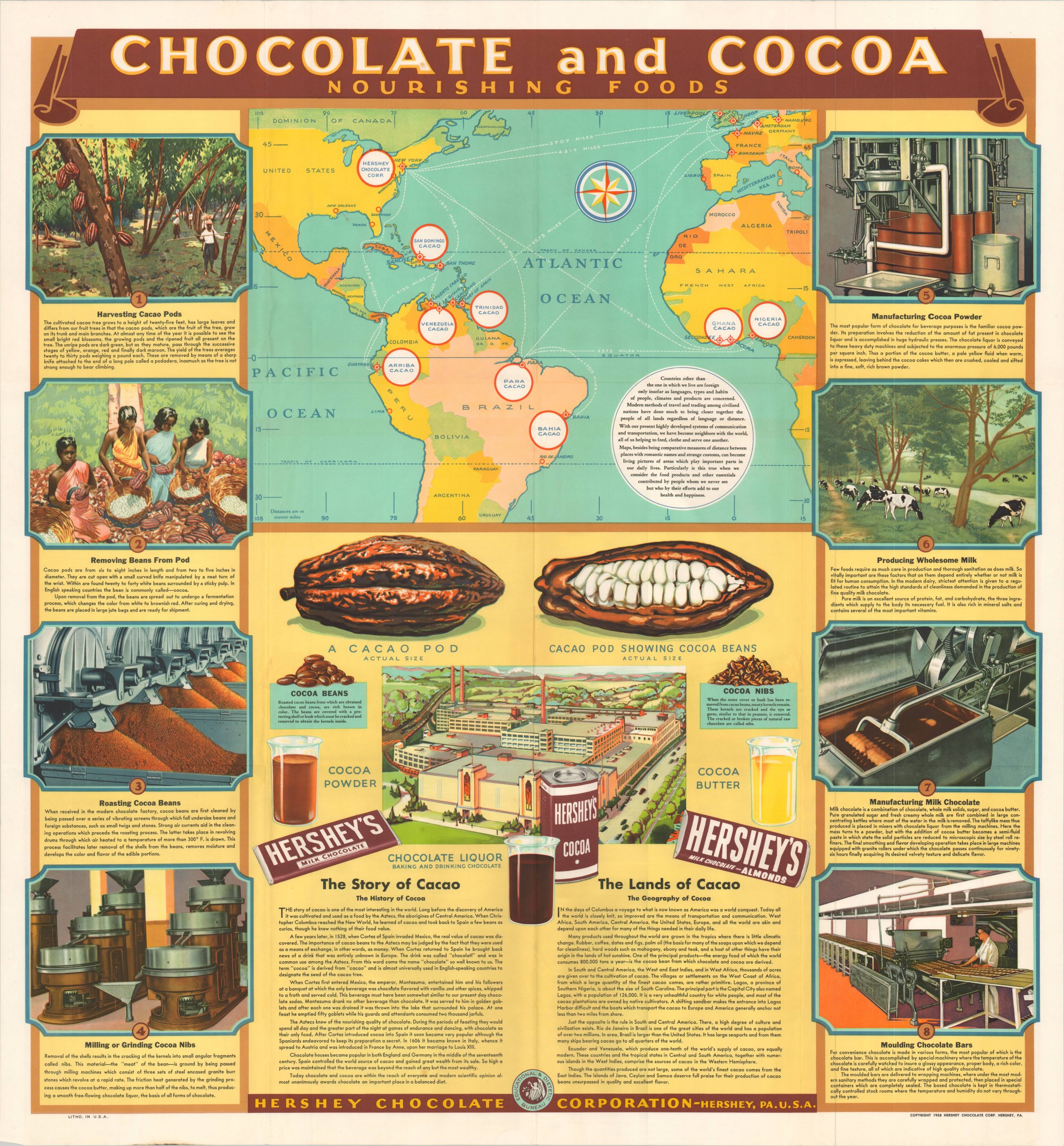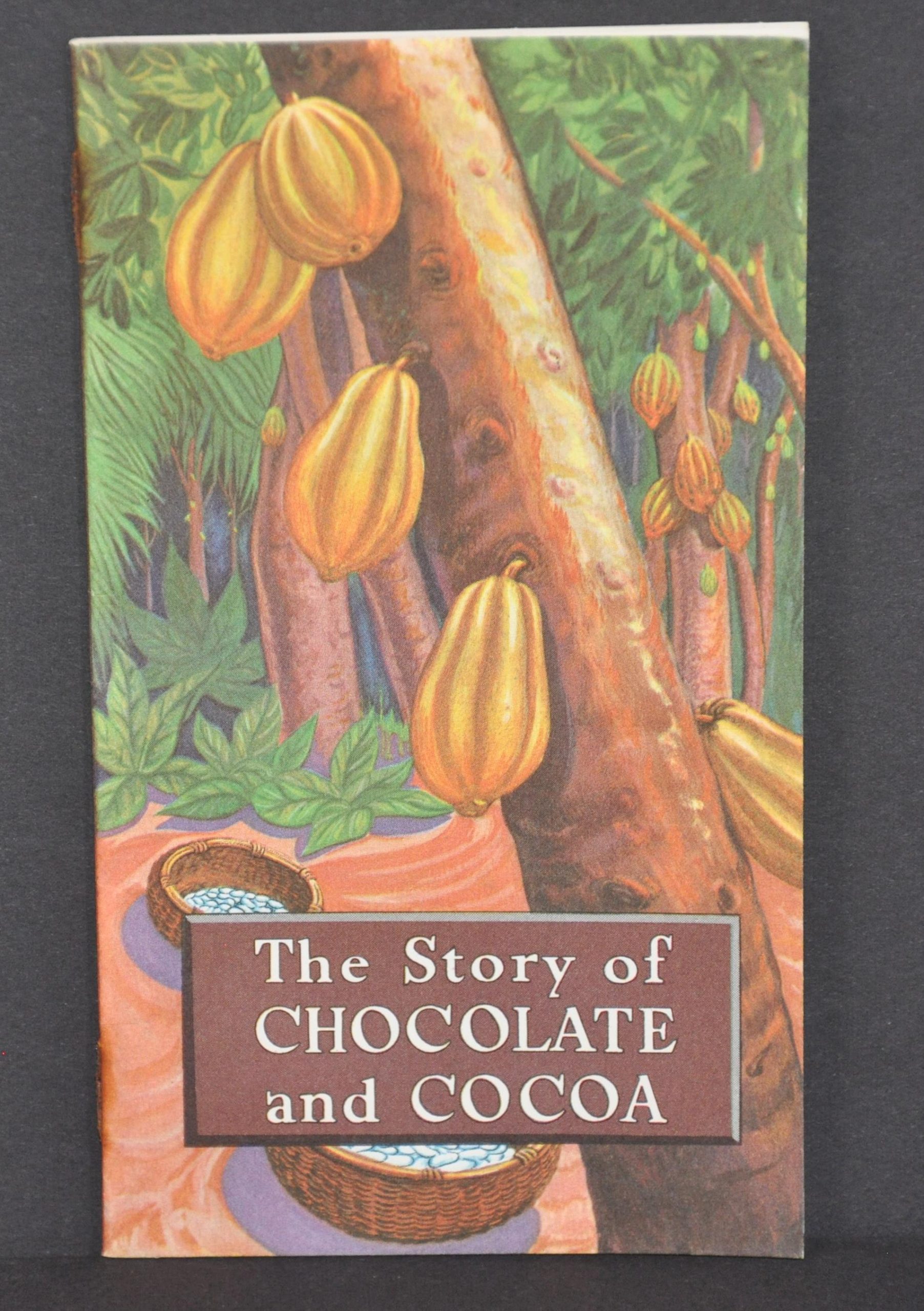Chocolate and Cocoa Nourishing Foods
Hershey’s Educational Chart to visualize clearly the complete process of manufacturing Chocolate and Cocoa [envelope]
Out of stock
Description
This incredible visual compendium of chocolate was first published in 1933 by the Hershey Chocolate Corporation of Hershey, Pennsylvania. This is a near fine example of the fourth (possibly final?) edition, updated by the company and re-issued in 1958.
One of America’s most iconic brands got its start from candy manufacturer Milton Hershey in Lancaster in 1894, who at that time focused on making caramels with fresh local milk. Wholesale chocolate was also part of the business, eventually justifying the creation of its own department within the business. A new recipe for milk chocolate was formulated in 1899, prompting the construction of a new plant in Hershey’s hometown of Derry Church, later renamed after the man who invested so much in the city. Popularity and consumption exploded, and by Hershey’s death in 1945 the candy has become ubiquitous across the country, even around the globe with the inclusion of Hershey bars in WWII field rations.
The wonderful broadsheet highlights the worldwide components of Hershey’s production process. The central map shows sources of cacao shipped from West Africa, South America, and the Caribbean, with an accompanying text marveling at the benefits of international trade. “With our present highly developed systems of communication and transportation, we have become neighbors with the world, all of us helping to feed, clothe, and serve one another.”
Below the map can be seen a life-sized image of the precious pod, while some of Hershey’s most popular products are pictured immediately underneath. ‘The Story of Cacao’ and ‘The Lands of Cacao’ described the history and geography of chocolate, respectively. One excerpt from the latter reads, “The villages or settlements on the West Coast of Africa, from which a large quantity of the finest cacao comes, are rather primitive…It is a very unhealthful country for white people, and most of the cacao plantations are owned by native cultivators…Just the opposite is the rule in South and Central America. There, a high degree of culture and civilization exist.”
On either side of the sheet, eight captioned illustrations show the process of manufacturing milk chocolate, from the collection of cacao pods to molding the bars. Of particular interest is #2, which shows a group of West African women extracting the beans individually by hand. Each pod, after being opened with a special knife or machete, contains between 20 and 50 beans, and approximately 400 beans are necessary to create one pound of chocolate. The all-important drying process takes several days and is mentioned, but not illustrated.
According to a 2018 article by Auburn University’s Center for Ethical Organizational Cultures, “With the majority of the global cocoa supply coming from Africa, the need for workers on plantations never dwindles, which has brought about the thriving business of child labor, slavery, and human trafficking across African borders. Many cocoa firms do not own the cocoa plantation and pay the land owner 50-66 percent of each year’s crop. To keep costs low, farmers often use their own family members as a source of labor.”
At least four separate editions were issued between 1933 and 1958, all of which are scarce on the market. OCLC notes two examples of the 1944 edition, at the University of Miami and the American Geographical Society Library at the University of Wisconsin-Milwaukee. A third edition, published in 1955, was previously sold by Barry Ruderman Antique Maps.
Map Details
Publication Date: 1958
Author: Hershey Chocolate Corporation
Sheet Width (in): 37.5
Sheet Height (in): 40.5
Condition: A
Condition Description: Large folding map with original postmarked mailing envelope and a 20 pp. booklet titled 'The Story of Chocolate and Cocoa.' The map is lightly creased along originally issued fold lines and the staples binding the pamphlet have rusted a bit, but otherwise in near fine condition overall.
Out of stock




